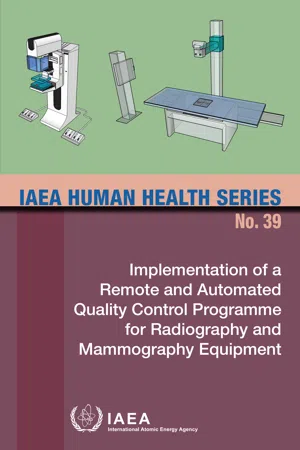1. INTRODUCTION
1.1. Background
In many areas of the world, medical physics support is minimal or non-existent. This leaves many facilities with little or no guidance to implement a quality assurance (QA) programme in the medical imaging department. Under these conditions, imaging devices may go through their entire useful life without ever being tested for regulatory compliance or for radiation safety and image quality. Quality control (QC) functions may never evaluate whether or not a given image is actually of adequate diagnostic quality. Such a paradigm can lead to inadequate patient care and excessive radiation exposure.
Radiographic imaging makes up the bulk of imaging done throughout the world. Even with rapid development and deployment of advanced imaging modalities such as computed tomography and magnetic resonance imaging, radiography remains central to patient care. In spite of this, radiographic imaging systems receive some of the least QC effort of any imaging modality. This remains true even in facilities that have access to medical physics services.
However, it is in the core definition of a QA programme that it is “an organized effort by the staff operating a facility to ensure that the diagnostic images produced by the facility are of sufficiently high quality so that they consistently provide adequate diagnostic information at the lowest possible cost and with the least possible exposure of the patient to radiation” [1]. While regulatory requirements may typically enforce annual performance evaluations, the monitoring of the imaging equipment cannot be limited to these acts if the clinical goal is consistent and adequate diagnostic information.
To help mitigate these situations, the IAEA embarked on developing a programme through which QC measures can be made simply and inexpensively, based on a straightforward, yet data-rich phantom and a software tool for image analysis. Measurement data or images can be analysed by means of the software tool that will then allow trend analysis and data archiving. The analysis system will alert the responsible clinically qualified medical physicists (CQMPs) if any measured value is out of limits or if a worrisome trend is developing.
Depending on the infrastructure of the facility, different forms of implementation can be envisioned. If a facility has digital radiography (DR) and a good information technology infrastructure, images of the phantom can be uploaded to a central server for analysis and determination of image quality. Alternatively, in case of limited network or on-line capabilities, the images could be automatically analysed locally, and the results could be transmitted for analysis. Finally, if a facility uses only screen–film imaging and has a limited infrastructure, the same phantom can be used and assessments can be made with simple optical density measurements, tracking of exposure parameters and artefact analysis. These results can then be entered into a database for analysis and CQMP oversight.
Through these measures, consistent system performance can be ensured, clinically adequate image quality can be maintained, patient safety can be increased, and overall patient care can be enhanced. In the long term, the data collected can be used to benchmark system quality performance between different systems also being monitored by this centralized programme.
Any well established QA programme involves both a comprehensive performance evaluation of the system, performed by a CQMP, and a less intensive QC test that could be performed by other assigned staff, such as a local medical radiation technologist, under the supervision of a CQMP.
Many Member States have established the regulatory framework and requirements for annual system performance testing by a CQMP. However, if frequent QC testing is missing from the QA programme, then the effectiveness of the programme is limited, as system deficiencies which may negatively impact image quality and patient care can arise in between such annual evaluations.
1.2. Objective
The aim of this publication is to provide a framework for QC of radiographic and mammographic imaging systems with remote and automated tools. The methods described can facilitate frequent constancy testing without the need for on-site supervision by a CQMP. Instead, the CQMP will have overall remote supervision of the QC programme which will allow for a regular review of the collected data. Along these lines, these tests are not intended to replace annual comprehensive performance evaluations of the radiographic systems by a CQMP. They can however detect deficiencies in system performance before they become clinically significant. Furthermore, frequent QC testing promotes a culture of quality in imaging.
Guidance provided here, describing good practices, represents expert opinion but does not constitute recommendations made on the basis of a consensus of Member States.
1.3. Scope
This publication is directed towards the following groups of professionals, all involved in ensuring an envir...
